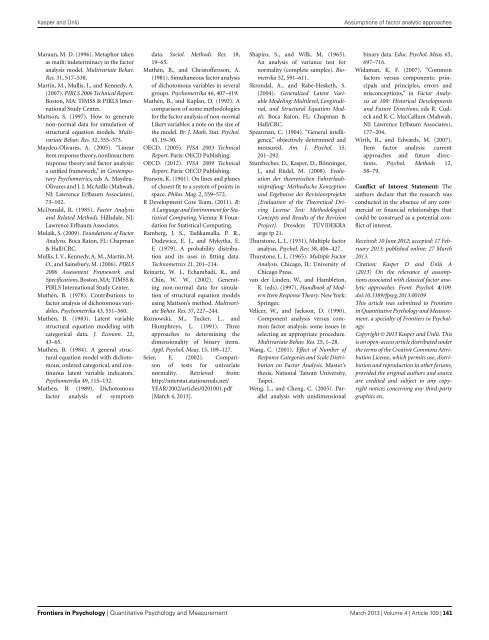Sweating the Small Stuff: Does data cleaning and testing ... - Frontiers
Sweating the Small Stuff: Does data cleaning and testing ... - Frontiers
Sweating the Small Stuff: Does data cleaning and testing ... - Frontiers
- No tags were found...
You also want an ePaper? Increase the reach of your titles
YUMPU automatically turns print PDFs into web optimized ePapers that Google loves.
Kasper <strong>and</strong> ÜnlüAssumptions of factor analytic approachesMaraun, M. D. (1996). Metaphor takenas math: indeterminacy in <strong>the</strong> factoranalysis model. Multivariate Behav.Res. 31, 517–538.Martin, M., Mullis, I., <strong>and</strong> Kennedy, A.(2007). PIRLS 2006 Technical Report.Boston, MA: TIMSS & PIRLS InternationalStudy Center.Mattson, S. (1997). How to generatenon-normal <strong>data</strong> for simulation ofstructural equation models. MultivariateBehav. Res. 32, 355–373.Maydeu-Olivares, A. (2005). “Linearitem response <strong>the</strong>ory, nonlinear itemresponse <strong>the</strong>ory <strong>and</strong> factor analysis:a unified framework,” in ContemporaryPsychometrics, eds A. Maydeu-Olivares <strong>and</strong> J. J. McArdle (Mahwah,NJ: Lawrence Erlbaum Associates),73–102.McDonald, R. (1985). Factor Analysis<strong>and</strong> Related Methods. Hillsdale, NJ:Lawrence Erlbaum Associates.Mulaik, S. (2009). Foundations of FactorAnalysis. Boca Raton, FL: Chapman& Hall/CRC.Mullis, I. V., Kennedy, A. M., Martin, M.O., <strong>and</strong> Sainsbury, M. (2006). PIRLS2006 Assessment Framework <strong>and</strong>Specifications. Boston, MA: TIMSS &PIRLS International Study Center.Muthén, B. (1978). Contributions tofactor analysis of dichotomous variables.Psychometrika 43, 551–560.Muthén, B. (1983). Latent variablestructural equation modeling withcategorical <strong>data</strong>. J. Econom. 22,43–65.Muthén, B. (1984). A general structuralequation model with dichotomous,ordered categorical, <strong>and</strong> continuouslatent variable indicators.Psychometrika 49, 115–132.Muthén, B. (1989). Dichotomousfactor analysis of symptom<strong>data</strong>. Sociol. Methods Res. 18,19–65.Muthén, B., <strong>and</strong> Christoffersson, A.(1981). Simultaneous factor analysisof dichotomous variables in severalgroups. Psychometrika 46, 407–419.Muthén, B., <strong>and</strong> Kaplan, D. (1992). Acomparison of some methodologiesfor <strong>the</strong> factor analysis of non-normalLikert variables: a note on <strong>the</strong> size of<strong>the</strong> model. Br. J. Math. Stat. Psychol.45, 19–30.OECD. (2005). PISA 2003 TechnicalReport. Paris: OECD Publishing.OECD. (2012). PISA 2009 TechnicalReport. Paris: OECD Publishing.Pearson, K. (1901). On lines <strong>and</strong> planesof closest fit to a system of points inspace. Philos. Mag. 2, 559–572.R Development Core Team. (2011). R:A Language <strong>and</strong> Environment for StatisticalComputing. Vienna: R Foundationfor Statistical Computing.Ramberg, J. S., Tadikamalla, P. R.,Dudewicz, E. J., <strong>and</strong> Mykytka, E.F. (1979). A probability distribution<strong>and</strong> its uses in fitting <strong>data</strong>.Technometrics 21, 201–214.Reinartz, W. J., Echambadi, R., <strong>and</strong>Chin, W. W. (2002). Generatingnon-normal <strong>data</strong> for simulationof structural equation modelsusing Mattson’s method. MultivariateBehav. Res. 37, 227–244.Roznowski, M., Tucker, L., <strong>and</strong>Humphreys, L. (1991). Threeapproaches to determining <strong>the</strong>dimensionality of binary items.Appl. Psychol. Meas. 15, 109–127.Seier, E. (2002). Comparisonof tests for univariatenormality. Retrieved from:http://interstat.statjournals.net/YEAR/2002/articles/0201001.pdf[March 4, 2013].Shapiro, S., <strong>and</strong> Wilk, M. (1965).An analysis of variance test fornormality (complete samples). Biometrika52, 591–611.Skrondal, A., <strong>and</strong> Rabe-Hesketh, S.(2004). Generalized Latent VariableModeling: Multilevel, Longitudinal,<strong>and</strong> Structural Equation Models.Boca Raton, FL: Chapman &Hall/CRC.Spearman, C. (1904). “General intelligence,”objectively determined <strong>and</strong>measured. Am. J. Psychol. 15,201–292.Sturzbecher, D., Kasper, D., Bönninger,J., <strong>and</strong> Rüdel, M. (2008). Evaluationder <strong>the</strong>oretischen Fahrerlaubnisprüfung:Methodische Konzeptionund Ergebnisse des Revisionsprojekts[Evaluation of <strong>the</strong> Theoretical DrivingLicense Test: MethodologicalConcepts <strong>and</strong> Results of <strong>the</strong> RevisionProject]. Dresden: TÜV|DEKRAarge tp 21.Thurstone, L. L. (1931). Multiple factoranalysis. Psychol. Rev. 38, 406–427.Thurstone, L. L. (1965). Multiple FactorAnalysis. Chicago, IL: University ofChicago Press.van der Linden, W., <strong>and</strong> Hambleton,R. (eds). (1997). H<strong>and</strong>book of ModernItem Response Theory. New York:Springer.Velicer, W., <strong>and</strong> Jackson, D. (1990).Component analysis versus commonfactor analysis: some issues inselecting an appropriate procedure.Multivariate Behav. Res. 25, 1–28.Wang, C. (2001). Effect of Number ofResponse Categories <strong>and</strong> Scale Distributionon Factor Analysis. Master’s<strong>the</strong>sis, National Taiwan University,Taipei.Weng, L., <strong>and</strong> Cheng, C. (2005). Parallelanalysis with unidimensionalbinary <strong>data</strong>. Educ. Psychol. Meas. 65,697–716.Widaman, K. F. (2007). “Commonfactors versus components: principals<strong>and</strong> principles, errors <strong>and</strong>misconceptions,” in Factor Analysisat 100: Historical Developments<strong>and</strong> Future Directions, eds R. Cudeck<strong>and</strong> R. C. MacCallum (Mahwah,NJ: Lawrence Erlbaum Associates),177–204.Wirth, R., <strong>and</strong> Edwards, M. (2007).Item factor analysis: currentapproaches <strong>and</strong> future directions.Psychol. Methods 12,58–79.Conflict of Interest Statement: Theauthors declare that <strong>the</strong> research wasconducted in <strong>the</strong> absence of any commercialor financial relationships thatcould be construed as a potential conflictof interest.Received: 10 June 2012; accepted: 17 February2013; published online: 27 March2013.Citation: Kasper D <strong>and</strong> Ünlü A(2013) On <strong>the</strong> relevance of assumptionsassociated with classical factor analyticapproaches. Front. Psychol. 4:109.doi:10.3389/fpsyg.2013.00109This article was submitted to <strong>Frontiers</strong>in Quantitative Psychology <strong>and</strong> Measurement,a specialty of <strong>Frontiers</strong> in Psychology.Copyright © 2013 Kasper <strong>and</strong> Ünlü. Thisis an open-access article distributed under<strong>the</strong> terms of <strong>the</strong> Creative Commons AttributionLicense, which permits use, distribution<strong>and</strong> reproduction in o<strong>the</strong>r forums,provided <strong>the</strong> original authors <strong>and</strong> sourceare credited <strong>and</strong> subject to any copyrightnotices concerning any third-partygraphics etc.<strong>Frontiers</strong> in Psychology | Quantitative Psychology <strong>and</strong> Measurement March 2013 | Volume 4 | Article 109 | 141














